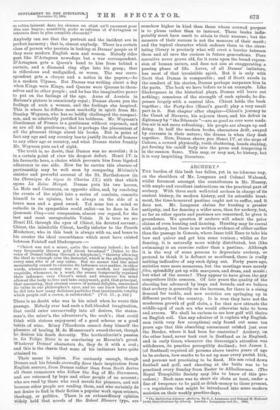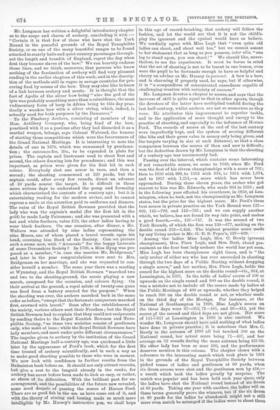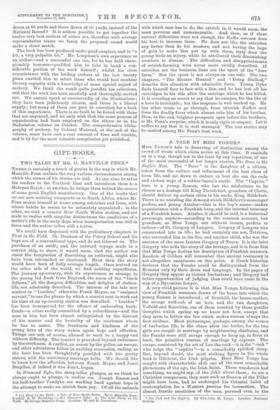ARC HE RY.* THE burden of this book has fallen,
yet in no irksome way, on the shoulders of Mr. Longman and Colonel Walrond, whilst foremost amongst the contributors is Mr. Hussey, with ample and excellent instructions on the practical part of archery. With three such well-tried archers in charge of its ancient history, its modern history, and its scientific treat- ment, the time-honoured pastime ought not to suffer, and it does not. Mr. Longman claims for hunting a greater antiquity, and for dancing a wider area, than for archery, but, as far as other sports and pastimes are concerned, he gives it precedence. We question if archers will admit the prior claims of even bunting and dancing. Hunting may be coeval with archery, but there is no written evidence of either earlier than the passage in Genesis, where Isaac told Esau to take his bow and quiver and get him some venison ; whilst as for dancing, it is naturally more widely distributed, but (like swimming) is an exercise rather than a pastime. Although it is the way of some persons to depreciate archery, or pretend to think it is defunct or moribund, there is really nothing indicative of any such dying out. Forty years ago, societies were more numerous, but the meetings were merely files, splendidly got up with marquees, and dress, and music ; but what of the scores? They appear to have given the gay competitors little concern. Of late years the quality of the shooting has advanced by leaps and bounds, and we believe that archery is generally on the increase, for there is a rising demand for tackle, and new societies are springing up in different parts of the country. It is true they have not the mushroom growth of golf clubs, a foe that now attracts the middle-aged of each sex who would otherwise take to bows and arrows. We shall be curious to see how golf will thrive on English soil. Can any admirer of it explain why English- men (with very few exceptions) only found out some ten years ago that this absorbing amusement existed just over the Border, where it had been for centuries ? Archery, on the other hand, never took root in Scotland as in England, and in early times, whenever the Sovereign's attention was withdrawn, its practice perceptibly declined ; but James I. (of Scotland) required all persons above twelve years of age to be archers, bow-marks to be set up near every parish kirk, and persons not practising to be fined. His son cried down football and golf, and shooting at the butts was to be practised every Sunday from Easter to Allhallowmas. (The Royal Toxophilite Society may like to know of this pre. cedent.) Each man was to shoot six shots at least, under a fine of twopence to be paid as drink-money to those present, —a regulation that might be introduced into some modern societies on their weekly practice-days.
• The Badmatem Library—Archery. By 0. J. Longman aud Colonel H. Walrond (with Contributions by others). London : Longman:: and Co. 1894,
Mr. Longman has written a delightful introductory chapter as to the scope and charm of archery, concluding it with :— "Certain it is that few of those who have shot the York Round in the peaceful grounds of the Royal Toxophilite Society, or on one of the many beautiful ranges to be found attached to stately halls and quiet country parsonages through- out the length and breadth of England, regret the day when first they became slaves of the bow." We can heartily endorse those lines, and we think, moreover, that persons who know nothing of the fascination of archery will find very pleasant reading in the earlier chapters of this work, and in the descrip- tion of the methods still in vogue in savage countries for pro. curing food by means of the bow. They may also like to know of a link between archery and music. It is thought that the fact of Apollo of the silver bow being "also the god of the lyre was probably something more than a coincidence, the most rudimentary form of harp in Africa being to this day prac- tically a wooden bow with a silver string, which, indeed, is actually used for both purposes by the Damarees."
To the Finsbury Archers, consisting of members of the Hon. Artillery Company, who, being fond of the bow,
practised with it as a pastime after they had discarded it as a martial weapon, belongs, says Colonel Walrond, the honour of starting those competitions which were the forerunners of the Grand National Meetings. It is interesting to note the details of one in 1676, which was summoned by proclama-
tion; the entrance-fee, 20s., to be expended in plate for prizes. The captain and lieutenant used to shoot first and second, the others drawing lots for precedence ; and this was important, as prizes were given for the first hit in each colour. Everybody shot one arrow in turn, and then a second ; the shooting commenced at 220 yards, but the captain could, after every few rounds, direct an advance of 10 yards nearer the target. It is difficult in these more serious days to understand the pomp and formality which characterised the contests of a century ago ; but it is entertaining reading for the modern archer, and he cannot repress a smile at the attention paid to uniforms and dinners.
The rules of the Royal British Bowmen provided that the lady who won the captain's medal (for the first hit in the gold) be made Lady Patroness; and she was presented with a hat and white feathers, value 210, the other ladies having to wear black feathers. On one occasion, after dinner, a Mr.
Walters was attended by nine ladies representing the
nine Muses, one of whom placed a laurel wreath upon his head, crowning him Bard of the Society. Can we picture
such a scene now, with " Avonvale" for the happy Laureate of some Devonshire Society P In 1788, a Mists Byng was pro- posed as a member, "in case she marries Mr. Bridgeman," and later in the year congratulations were sent to Mrs.
Bridgeman on her marriage, and she was requested to con- sider herself a member. The same year there was a meeting at Wynnstay, and the Royal British Bowmen "marched two and two to the shooting-ground, the music playing a new march, composed for the occasion, and colours flying. On their arrival at the ground, a royal salute of twenty-one guns was fired from a battery erected for the purpose." When the shooting was over, the archers marched back in the same order as before, "eieept that the fortunate conquerors marched first, crowned with laurel." Soon after the establishment of the society, various others sent their Freedom ; but the Royal British Bowmen had to explain that they could not reciprocate by sending theirs to the Royal Kentish Bowmen and Toxo- philite Society, "as these two societies consist of gentlemen only, who meet at inns ; while the Royal British Bowmen have lady members, and meet under quite different circumstances." The impulse given to archery by the institution of the Grand National Meetings half-a-century ago, was quickened a little later by the appearance of Ford's book, which for the first time treated of archery scientifically, and in. such a way as to make good shooting possible to those who were in earnest.
We now look with confidence to further results from the Badminton book before us. It should not only attract recruits, but give a zest to the languid already in the ranks, for archery has never before been made to look so easy, or rather, so shorn of its difficulties. With the brilliant past for en- couragement, and the possibilities of the future now revealed, none need despair of passing the scores of Horace Ford. There are as good fish in the sea as have come out of it, and with the theory of aiming and loosing made so much more intelligible by Mr. Hussey's instructive pen, we shall hope
in this age of record-breaking, that archery will follow the fashion, and let the world see that it is not the child's- play the ignorant and the cynical would have us believe. We cordially agree with Miss Legh that even quite old ladies can shoot, and shoot well too," but we cannot assent to her statement that as long as you possess, inter alio, "one leg to stand upon, you can shoot !" We should like, never- theless, to see the experiment. It must be borne in mind that the art of shooting is not to be learnt in one lesson, even were the pupil to be fortunate enough to have so helpful and cheery an adviser as Mr. Hussey inpersona. A bow is a bow, and is charming if properly used, he says, but if otherwise, it is "a compendium of concentrated cussedness capable of challenging creation with certainty of success."
Mr. Longman devotes a chapter to scores, and says that the increase of skill is quite equal to that in other sports, though the devotees of the latter have multiplied tenfold during the last half-century, whilst archers are not so numerous as they were. He attributes this improvement to superior tackle, and to the application of more thought and energy to the practice of shooting, and especially to the influence of Horace Ford. The records of scores at the end of the last century were imperfectly kept, and the system of scoring different (the hits and their gross value in money only being given, and the targets varying in size at each distance), so that a close comparison between the scores of then and now is difficult; but the deduction drawn by Mr. Longman is that the shooting of a century ago was uncommonly bad.
Passing over the interval, which contains some interesting if not remarkable scores, we come to 1849, when Mr. Ford won the first of his eleven championships with a score of 702; then to 1850 with 899, to 1853 with 931, to 1851 with 1,074, and to 1857 with 1,251,—a score which has never been approached. During these eleven years, the archer who got nearest to him was Mr. Edwards, who made 864 in 1858; and in the following year effected his overthrow, in 1859, at Lea- mington, when he took, not the championship as Mr. Longman states, but the prize for the highest score. Mr. Ford's three best scores in private practice on the York Round were 137— 809, 141-799, and 143-765; and we can supply another which, we believe, has not found its way into print, and makes a good fourth,—viz., 137-747. It was the second of two York Rounds, of which the first was 139-677, making on the doable round 276-1,424. The highest practice score made by any living archer is Mr. G. E. S. Fryer's, 127-639.
Among the ladies Miss Leer, Mrs. O. Bowly (present championess), Mrs. Piers Legh, and Mrs. Batt, stand pre- eminent as the four beet lady archers the world has yet seen. Miss Legh has been championess eight times, and is "the only archer of either sex who has ever succeeded in shooting through the two days of a Public Meeting without dropping a single arrow," and her mother, Mrs. Piers Legh, holds the record for the highest score on the double round—viz., 861, at Leamington, in 1885. In the table of ladies' scores of 400 or upwards on the single round and 800 on the double round, it was a mistake not to include all the scores made by ladies at the Public Meetings of 400 or upwards, whether they helped to reach 800 on the double round or not, or whether made on the third day of the Meetign. For instance, at the National at Southampton in 1890, Miss Legh's scores on the three days were 67-353, 71-415, and 69-413, yet the scores of the second and third days are not given. Her score of I41—' 817 at Leamington in 1888 is also omitted. We wonder Mr. Longman should have said nothing of what ladies have done in private practice ; it is notorious that Mrs. C. Bowly in the autumn of 1893 all but touched 500 on the National round, her actual score being 71-497, and her average on 52 rounds during the same autumn being 42550. No other lady haa been so near 500, and the performance deserves mention in this volume. The chapter closes with a reference to the interesting match which took place in 1891 in the grounds of the Royal Toxophilite Society between picked teams of ladies and gentlemen at 60 yards, when six dozen arrows were shot and the gentlemen won by 416,- a result which took the ladies greatly by surprise. The match was popular and. has been held each year since, only the ladies have shot the National round instead of six dozen at 60 yards. Taking one year with another, the ladies will on these terms generally prove the winners, but if the six dozen at 60 yards for the ladies be abandoned, might not a still more even match be arranged if the ladies were to shoot three dozen at 60 yards and three dozen at 50 yards, instead of the National Round P It is seldom possible to get together the twelve very best archers of either sex, therefore with average representative teams we fancy the proposed round would make a closer match.
The book has been produced under good auspices, and is "a hit, a very palpable hit." Mr. Longman's own experience as an archer—and a successful one too, for he has held cham- pionship honours—qualified him to take in hand a con- siderable portion of the work himself ; whilst his close acquaintance with the leading archers of the 18,st twenty years enabled him to select those who would best combine literary capaeity with a knowledge of some special aspect of archery. We think the result quite justifies his selections, and that the work has been carefully and thoroughly carried out. We cannot speak so unreservedly of the illustrations ; they have been judiciously chosen, and there is a liberal supply; but many of them are poor in execution for a book of this importance. There is no fault to be found with those that are engraved, and we only wish that the same process of reproduction had been employed on the others as in the Badminton volume on Cricket. The comprehensive biblio- graphy of archery, by Colonel Walrond, at the end of the volume, must have cost a vast amount of time and trouble, and is by far the most valuable compilation yet published.




















































 Previous page
Previous page